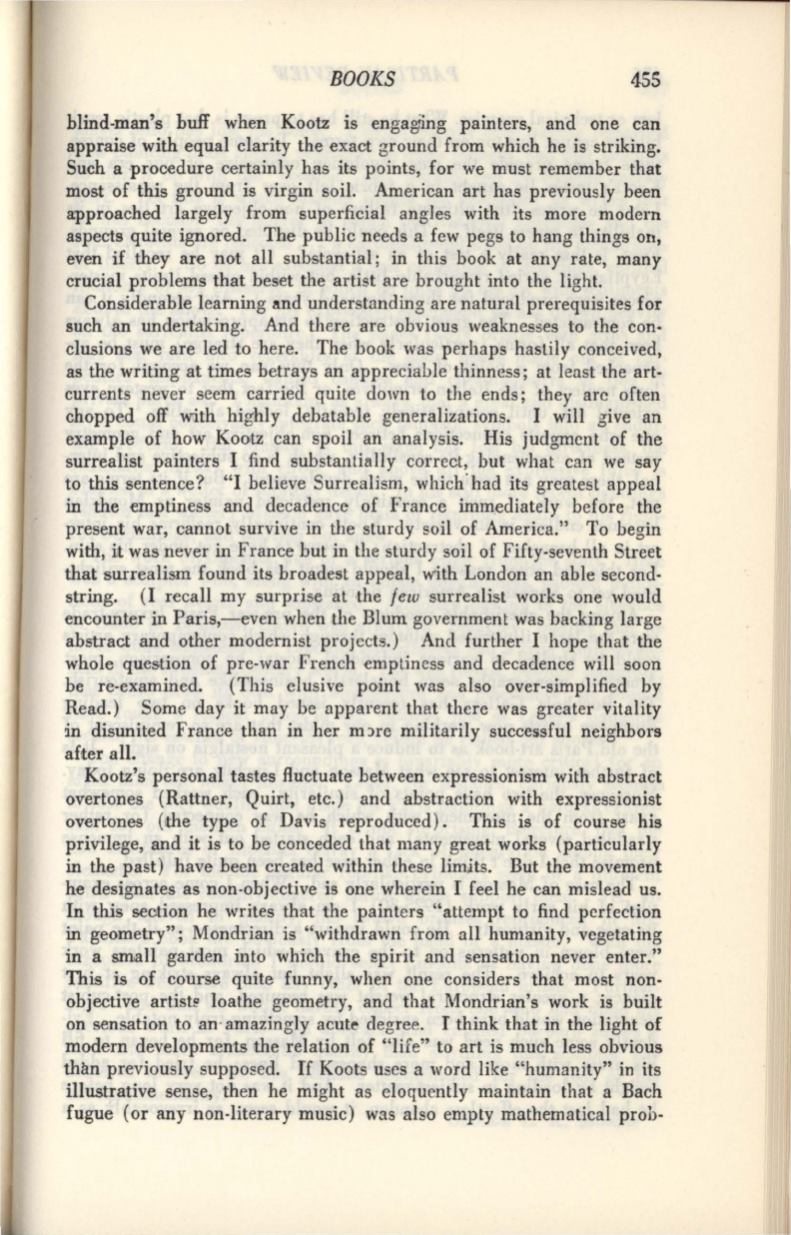
BOOKS
455
blind-man's huff when Kootz is engag.1ng painters, and one can
appraise with equal clarity the exact ground from which he is striking.
Such a procedure certainly has its points, for we must remember that
most of this ground is virgin soil. American art has previously been
approached largely from superficial angles with its more modern
aspects quite ignored. The public needs a few pegs to hang things on,
even if they are not all substantial; in this book at any rate, many
crucial problems that beset the artist are brought into the light.
Considerable learning and understanding are natural prerequisites for
such an undertaking. And there are obvious weaknesses to the con–
clusions we are led to here. The book was perhaps hastily conceived,
as the writing at times betrays an appreciable thinness; at least the art–
currents never seem carried quite down to the ends; they arc often
chopped off with highly debatable generalizations. I will give an
example of how Kootz can spoil an analysis. His judgment of the
surrealist painters I find substantially correct, but what can we say
to this sentence? "I believe Surrealism, which·had its greatest appeal
in the emptiness and decadence of France immediately before the
present war, cannot survive in the sturdy soil of America." To begin
with, it was never in France but in the sturdy soil of Fifty-seventh Street
that surrealism found its broadest appeal, with London an able second–
string. (I recall my surprise at ,the
few
surrealist works one would
encounter in Paris,-even when ,the Blum government was backing large
abstract and other modernist projects.) And further I hope that the
whole question of pre-war French emptiness and decadence will soon
be re-examined. (This elusive po,int was also over-simplified by
Read.) Some day it may be apparent that there was greater vitality
in disunited France than in her m
ne
militarily successful neighbors
after all.
Kootz's personal tastes fluctuate between expressionism with abstract
overtones (Rattner, Quirt, etc.) and abstraction with expressionist
overtones (the type of Davis reproduced). This is of course his
privilege, and it is to be conceded that many great works (particularly
in the past) have been created within these
lim~ts.
But the movement
he designates as non·objective is one wherein I feel he can mislead us.
In this section he writes that the painters "attempt to find perfection
in geometry"; Mondrian is "withdrawn from all humanity, vegetating
in a small garden into which the spirit and sensation never enter."
This is of course quite funny, when one considers that most non–
objective artists loathe geometry, and that Mondrian's work is built
on sensation to an·amazingly a
cut~
degree. I think that in the light of
modern developments the relation of "life" to art is much less obvious
th1m previously supposed.
If
Koots uses a word like "humanity" in its
illustrative sense, then he might as eloquently maintain that a Bach
fugue (or any non-literary music) was also empty mathematical prob-


